Easy Moussaka Recipe (Ultimate Guide!)
on Sep 07, 2022
This post may contain affiliate links. Please read my disclosure for more info.
If you’ve never tried making moussaka, don’t wait another day to make this easy version. With its delicious layers of roasted eggplant, Greek bolognese sauce and souffle-like cheesy béchamel sauce, this classsic Greek dish is a bit like lasagna… but even more delicious!
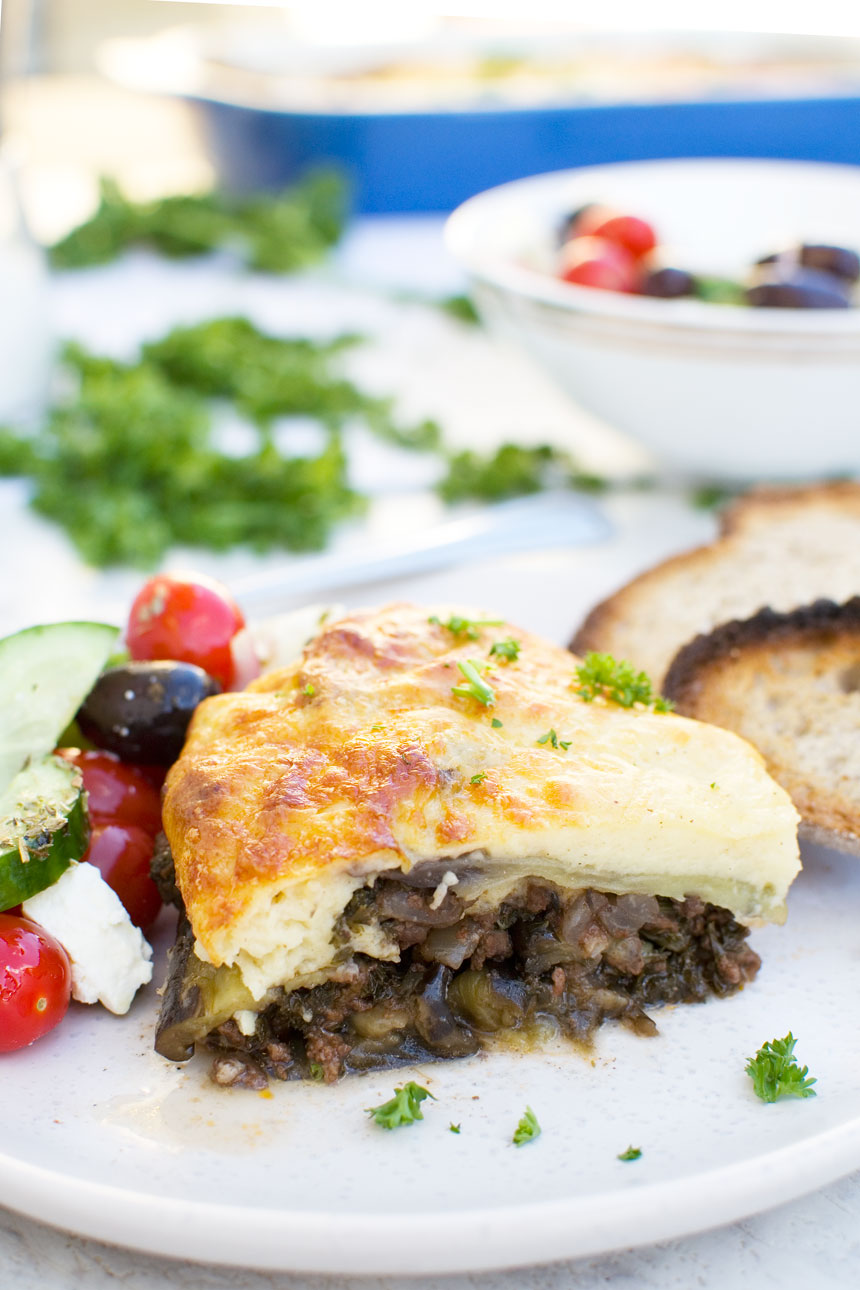
What’s moussaka?
Moussaka (pronounced mousse-ah-KA in Greek!) is one of the most well known and traditional Greek recipes. It’s a kind of Greek eggplant casserole with layers of eggplant/aubergine, spiced bolognese sauce and Greek style béchamel sauce. It’s a bit – but not entirely – like a lasagna (see below for a comparision!).
There are as many versions as there are Greek yia-yias (grandmas!). I ate many while living in Greece, and nearly all were incredibly delicious!
A classic moussaka is made of ground lamb (lamb mince), but I’ve found that most restaurants in Greece make theirs out of ground beef (beef mince). To be frank, beef is cheaper and easier to get hold of, so who can blame them?
Traditionally, this meal also contains potato slices, but you won’t find any potato in my easy moussaka recipe! Why? Well it’s obviously going to be easier and quicker to make without potatoes, but also I just don’t think the recipe needs it.
I would much rather make these amazing Greek potatoes (and trust me, they really are amazing!) as a side dish.
The difference between moussaka and lasagna
I suppose you could say an eggplant moussaka is a bit like a Greek lasagna! But it doesn’t have any pasta sheets in it – it has layers of lower carb baked eggplant instead.
The bolognese sauce made of spiced ground meat (usually beef or lamb) is less tomato-y than the one in a lasagna. It also contains lots of wine and yummy Greek flavours (namely oregano and cinnamon – yes, cinnamon!).
The béchamel sauce on top is a bit different to lasagna béchamel, too. You make it in a similar way, but then you add parmesan cheese (or pecorino or Greek kefalotyri if you can find it) and whisked eggs. The eggs make the sauce ‘puff up’ a bit in the oven, a bit like a soufflé.
A ‘Greek lasagna’ is beyond delicious. It’s the ultimate Greek comfort food!
Why you’ll love this recipe
You know those recipes that just ‘work’ for you? You find yourself making them again and again, learning little tricks to improve the recipe along the way.
For us, this easy moussaka is one of those recipes (along with this one pan baked chicken and chorizo). I’ve made it more times than I can count, ‘just for us’ for a midweek meal, and also for guests with a horiatiki salata (Greek salad) on the side.
I found the recipe a few years ago in an article called How to Cook Perfect Moussaka in the Guardian newspaper. I chose to base my recipe on that one simply because it was a really easy version, but still tasted really rich and delicious.
And we’re all about easy around here!
Here’s a summary of what I love.
✔ Although there are 3 components to the recipe, you only need a few simple ingredients for each step.
✔ The eggplant/aubergine slices are baked, not fried. No need to fry them in oil, no need to salt them in my humble opinion!
✔ I’ve fine-tuned the quantities of delicious Greek herbs and spices in it, so it’s super tasty – full of authentic flavor!
✔ It’s make-ahead friendly. You can make the recipe even simpler by roasting the eggplant slices ahead (for example the day before) and by making the béchamel as the meat sauce is bubbling away on the stove.
✔ In fact, you can fully assemble the moussaka ahead of time. Either pop it in the fridge (unbaked) for up to a day, or freeze it unbaked for even longer.
✔ It’s pretty economical! As it’s quite rich-tasting, you only need a small piece. Especially if you’re going to serve it with delicious sides like Greek potatoes and a Greek salad. One moussaka can serve at least 8 people. We usually eat it for 1 or 2 meals, then I freeze the rest.
5 star review *****
“This was so delicious! I was a little hesitant about the cinnamon, but it adds such an amazing flavor! Thanks for this great recipe!” (Wilhemina)
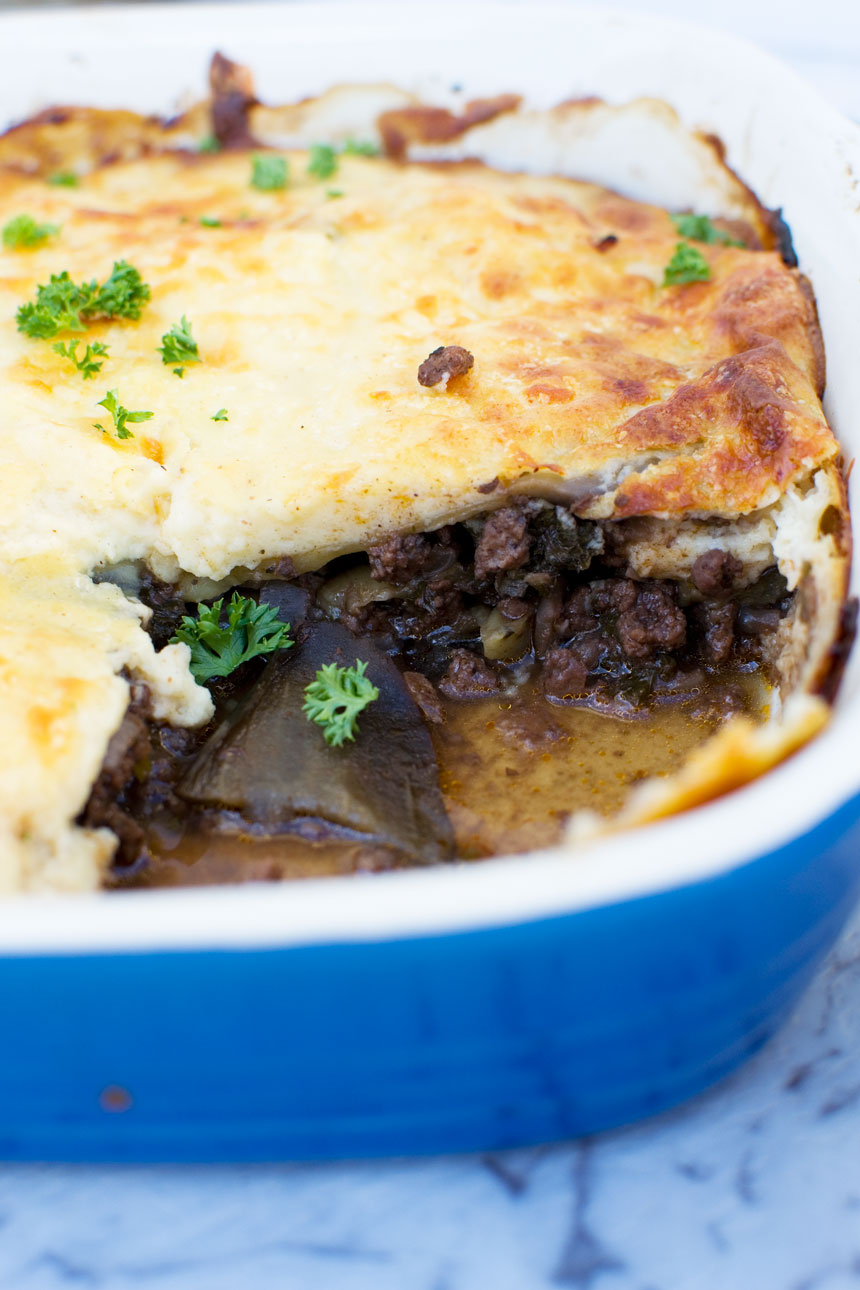
About the ingredients
For the roasted eggplant/aubergine layer (2 ingredients, 3 layers)
Eggplant slices (2 to 3 eggplant): I usually grab 3 medium or 2 large regular dark purple eggplant. Some readers have reported using other types of eggplant (grafiti, white etc.), which is fine – just adjust the amount you use depending on the size.
Extra virgin olive oil: You’ll use about 1/4 cup for brushing all over the eggplant slices, so try to choose a good quality olive oil.
For the bolognese sauce layer (7 ingredients, 2 layers)
Onions & garlic, dried oregano & cinnamon: You can use regular white onion or red onion.
Ground meat: I usually go for a low fat ground beef/beef mince. Feel free to use ground lamb, or even chicken, turkey, pork or a mixture instead if you prefer.
Red wine: I think including this makes all the difference to the flavor of the sauce. However, feel free to replace with a good quality beef or chicken stock if you prefer.
Tomato paste (mixed with water and the wine): By this I mean the concentrated stuff, not passata or pasta sauce. Note that in the UK this is usually called tomato puree or concentrate.
Fresh parsley: You’ll stir this into the sauce at the end. I’ve used both flat leaf parsley and curly parsley – either are fine.
For the bechamel sauce layer (5 ingredients, 1 layer on the top)
Flour: Just ordinary all-purpose/plain white flour. Gluten free will work.
Butter: Regular unsalted butter.
Milk (warmed): I’ve used full fat and half fat – either are fine.
Grated cheese: Traditionally, Greek béchamel sauce for moussaka contains kefalotyri cheese (a hard, salty white cheese made from sheep’s or goat’s milk). Graviera (gruyère) is a good substitute, but I’ll be honest – I usually use either Italian pecorino or even parmesan cheese. All of these options are fine.
Nutmeg: I’d say this is an essential ingredient in the béchamel to get an authentic flavor. You only need a little, and either ready ground nutmeg or a little ground from a whole nutmeg is fine.
Eggs: You’ll need 2 large eggs, lightly whisked. This is what makes the sauce ‘puff up’ and have the consistency of a soufflé rather than a classic béchamel sauce.
How to make moussaka step-by-step
The step-by-step guide below should help you make the recipe perfectly first time. Scroll down to the end for the full recipe including ingredient amounts.
I promise it’s not too hard. There are 3 components to this Greek moussaka recipe, but all 3 are super easy. Have fun!
1. The eggplant/aubergine
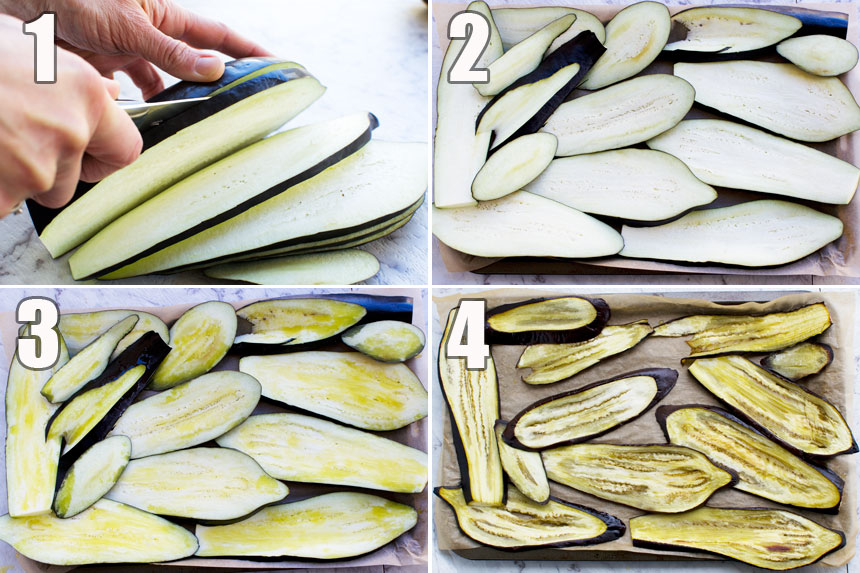
(Photo 1) Cut the eggplant/aubergines into even(ish) slices lengthwise. It’s difficult to slice them to exactly the same thickness, but 1/2 to 1cm is about ideal.
(Photos 2-3) Lay the eggplant/aubergine slices on baking trays in 1 layer (it’s OK if they overlap slightly). Brush them on both sides with a little olive oil.
(Photo 4) Roast the eggplant/aubergine for about 25 minutes until soft.
Pro tip: Roast the eggplant slices ahead! The recipe feels even easier if you have these all ready to go (just like you would already have your lasagna sheets ready when making a lasagna). You can even freeze the roasted eggplant and then let them defrost on the day you’re making your moussaka. Any leftovers? Make this Italian toasted veggie sandwich! You won’t regret it!
2. The Greek bolognese sauce
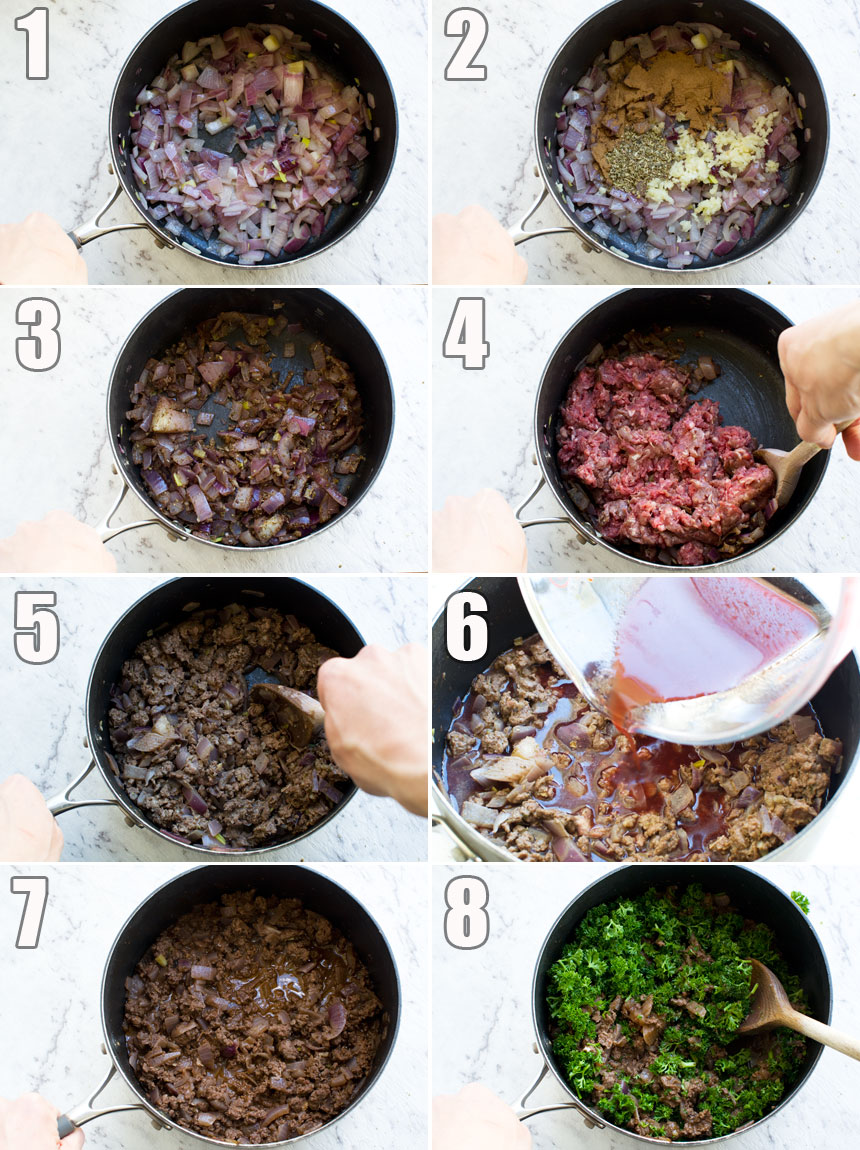
(Photo 1) Soften onions in a bit of olive oil.
(Photos 2-3) Add cinnamon, oregano and garlic, and stir!
(Photos 4-5) Add the meat. Break up and stir until browned a little.
(Photos 6-7) Add wine, tomato concentrate/paste, and water, then simmer for about half an hour until well reduced.
(Photo 8) Add plenty of chopped parsley.
3. The bechamel topping
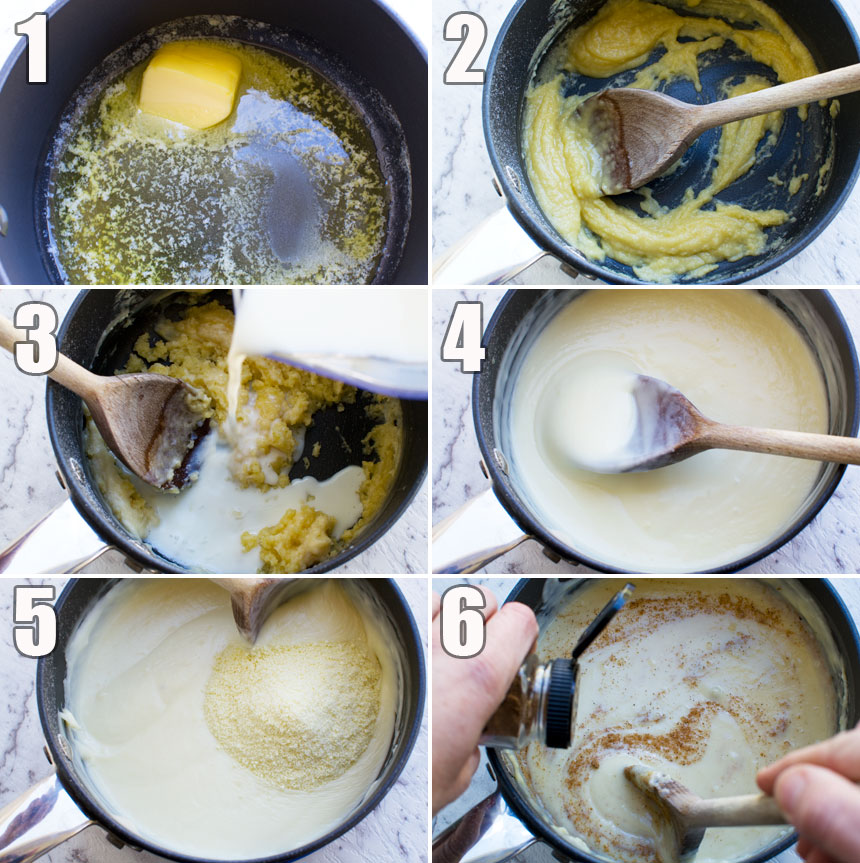
(Photo 1) Melt butter in a medium saucepan.
(Photo 2) Add the flour while still on the heat and stir for about a minute.
(Photo 3) Vigorously stir in warmed milk. But do it little by little so there are no lumps! If there are a few lumps at first, you’ll find they will dissolve into the sauce by the time you’ve added all the milk.
(Photo 4) Continuously stir on a medium heat until the sauce starts to bubble and thicken nicely.
(Photos 5-6) Stir in about 3/4 of the grated cheese. Let cool slightly (so that you don’t get scrambled eggs!), then whisk in the eggs and nutmeg.
4. How to assemble
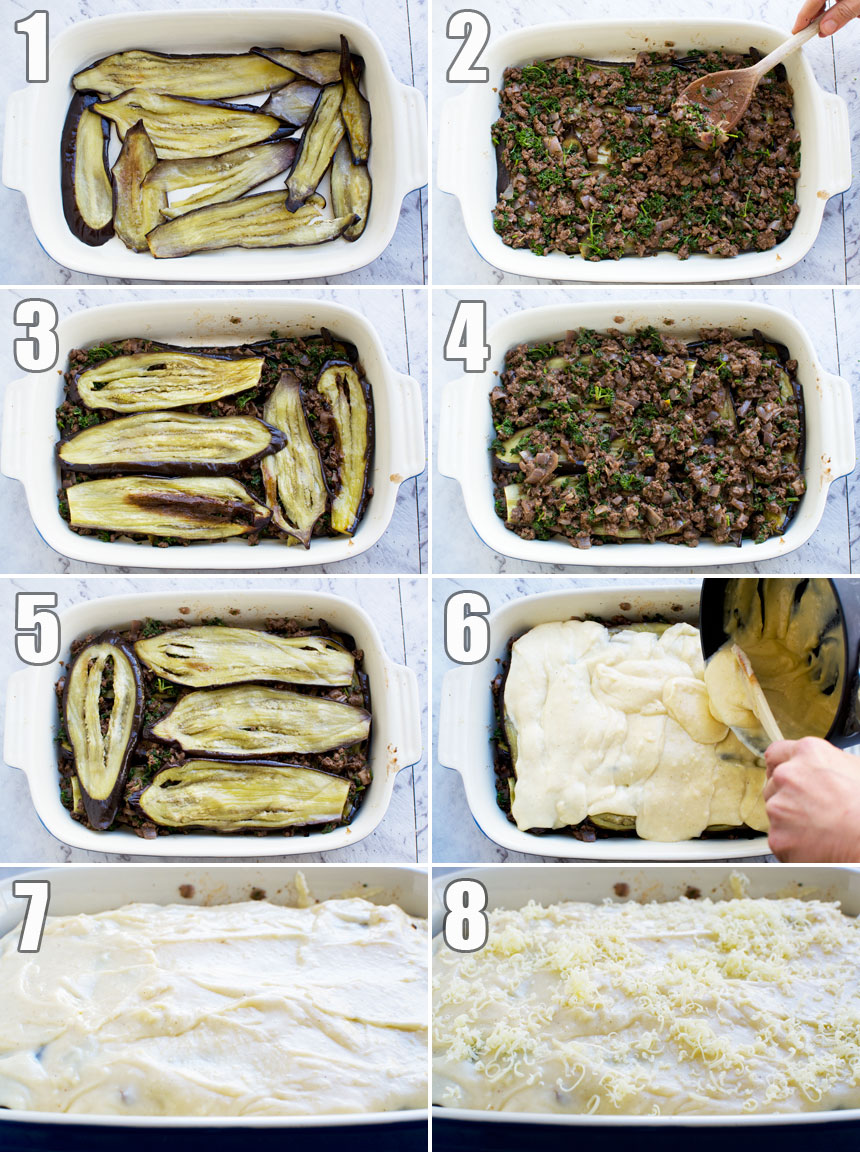
(Photo 1) Divide your eggplant/aubergine slices into 3 piles. Take the first pile and lay them over the bottom of your baking dish.
(Photo 2) Spoon over about half of the meat sauce. It will be a thin layer of sauce, but that’s OK!
(Photos 3-4) Repeat the next layer with the second pile of eggplant/aubergine slices and the rest of the meat sauce.
(Photos 6-8) Pour the bechamel sauce over the top and spread out evenly. Sprinkle with the grated cheese that you set aside when making the sauce.
5. Baking
Bake for about 45 minutes until golden and bubbling.
Pro tip: After you take your moussaka out of the oven, let it ‘rest’ for about 20 minutes. It will still be hot, but the pieces will hold together better when you serve them.
How to serve
In my very humble (but well researched) opinion, a Greek eggplant moussaka is best served with a Greek village salad. You just can’t go wrong. As a slight variation, a Greek lettuce salad (maroulosalata) would go very well, too, and is even easier to make.
Personally I also like to serve it with 2-minute toasted bread drizzled with olive oil and sprinkled with salt. If you want to go the extra mile (I think it’s worth it!), try this easy Greek village bread.
Sometimes (usually if we have leftovers the next day) I make some Greek potatoes, too. Then you truly feel like you’re having a meal in a Greek taverna!
For me, the final touch is some tsatziki sauce to serve on the side. It only takes 10 minutes to make, but even just plain Greek yogurt works if you want to keep things super simple.
An alternative to tsatziki is this incredible 5-minute and 5-ingredient tyrokafteri or Greek spicy feta dip. Or serve the dip as an appetizer to get your guests in the mood for their Greek taverna experience!
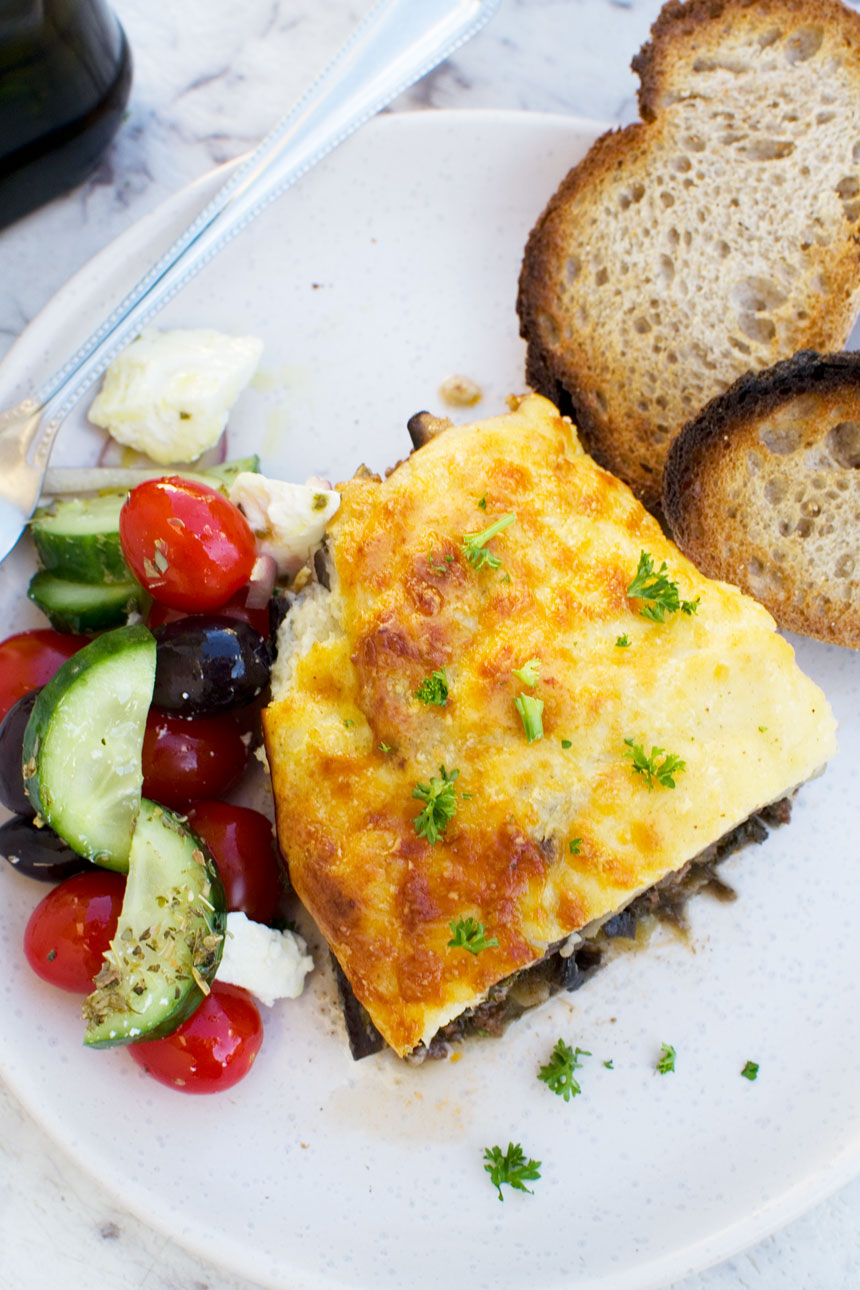
Variations
I’ll be honest – I usually just stick with the classic recipe, just as it is. But there are a few changes you can make, if you like.
- Vary the type of ground meat. Feel free to use ground (minced) lamb, turkey, chicken, pork, or a mixture of beef and pork. You can even use a plant-based ‘meat’ if you’d like to try a vegetarian version.
- OK, so this recipe doesn’t have any potato in it. But there are no rules against adding some if you like. Simply roast some thin potato slices along with the eggplant slices and include a layer at the bottom of the dish when assembling.
- Same goes with zucchini slices! Simply roast with the eggplant, but take out of the oven a little earlier – after about 15 minutes only.
- Want to make the béchamel even easier, and a little lighter? You can try making a no-cook ‘cheat’s bechamel sauce’ instead. Simply slowly mix 1.25 cups of Greek yogurt into a tablespoon of cornflour (corn-starch) in a medium bowl. Then mix in the eggs, parmesan and nutmeg as in the regular recipe. This isn’t as soufflé-like as regular béchamel, but it’s still pretty tasty.
Moussaka FAQ
Definitely! I often fully assemble my beef moussaka in the morning, then cover it and pop it in the fridge until evening. In fact, you can assemble it up to a day before you want to cook it.
Or you can freeze it after assembling (let cool completely, then wrap really well in several layers of plastic wrap or aluminum foil). When you’re ready to eat it, either let defrost in the fridge overnight, then cook as normal. Or cook straight from frozen and add another 20 to 25 minutes onto the cooking time. You’ll see when it’s done – it will be browned, bubbling and delicious looking!
Which leads me onto the next common question…
Yes! See above!
If you want to freeze cooked leftovers, simply put separate portions into glass containers and freeze for up to 3 months.
Got leftovers? They’ll last for up to 5 days in an airtight container in the fridge! Reheat at 355F/180C for about 25 minutes.
Alternatively, you can reheat each piece separately in the microwave for a few minutes. You might not get that lovely puffed up béchamel that you’ll get if you reheat it in the oven, but it’ll taste just as good!
More amazing moussaka recipes
- Papoutsakia (stuffed eggplant that tastes very similar to moussaka!)
- Skinny chicken moussaka (a lighter version made with ground chicken and a cheat’s béchamel)
- Moussaka penne (30-minute pasta dinner that tastes like moussaka)
- Authentic pastitsio recipe (like a cross between moussaka and lasagna)
More favorite Greek dinners
- This Greek lamb with lemony garlic potatoes is highly recommended if you’re looking to impress!
- This Baked Greek chicken and potatoes and this similar biftekia (Greek burgers) have come to my rescue time after time. They’re so easy – not to mention delicious served with a big Greek salad.
- These Greek stuffed peppers and tomatoes (gemista) are pretty epic. You have to try them to find out why!
- Greek oven baked fish (your new favourite way to cook fish!)
- This baked Greek chicken orzo is a tasty and super easy one pot meal everyone will love.
- I love these vegetarian options – an easy stovetop version of classic ‘gigantes plaki’ (Greek giant baked beans!) or a One pan Greek couscous with halloumi.
Or if you’re just enjoying the whole Greek food vibe in this post, you might like to check out my Greek recipes archives!
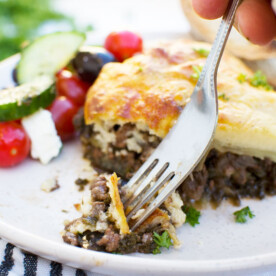
Easy Moussaka Recipe (Ultimate Guide!)
Equipment
Ingredients
For the eggplant/aubergine slices
- 2 large eggplant, / aubergines, cut into even ½ – 1 cm slices
- ¼ cup olive oil, approximately
For the Greek bolognese sauce
- 1 onion, finely chopped
- 4 garlic cloves, crushed or chopped
- 2 teaspoons cinnamon
- 1½ teaspoons dried oregano
- 1 pound ground beef, or lamb (ground beef = minced beef in UK/Australia)
- 2 tablespoons tomato paste, mixed with about ½ cup/125ml water (= tomato puree or concentrate in UK)
- ⅔ cup red wine, (Replace with good quality beef or chicken stock/broth if you prefer)
- ½ teaspoon salt
- ¼ teaspoon pepper
- 1 bunch fresh parsley, chopped
For the béchamel sauce
- 4 tablespoons butter
- 4 tablespoons plain flour
- 2 cups milk, warmed slightly in the microwave or in a pan
- ⅔ cup parmesan cheese, or Italian pecorino / Greek kefalotyri if you can find it!
- ¼ tsp nutmeg, ground or grated from a whole nutmeg
- 2 eggs, lightly whisked
Instructions
Eggplant/Aubergine slices
- Pre-heat the oven to 355F/180C. Lay the eggplant/aubergine slices on large baking trays and brush each side with a little olive oil. Bake for about 25 minutes or until the slices are soft.2 large eggplant, ¼ cup olive oil
Meat sauce
- Meanwhile, make your meat sauce. Heat a little olive oil in a large saucepan, then cook the onion for a few minutes. Add the garlic, cinnamon & oregano and cook for a minute longer.1 onion, 4 garlic cloves, 2 teaspoons cinnamon, 1½ teaspoons dried oregano
- Add the meat to the pan and brown while breaking up with a wooden spoon.1 pound ground beef
- Add the tomato paste/puree, water and wine. Simmer the sauce until it has thickened (about 30 minutes).2 tablespoons tomato paste, ⅔ cup red wine
- Stir in the parsley and salt and pepper to taste.½ teaspoon salt, ¼ teaspoon pepper, 1 bunch fresh parsley
Béchamel
- To make the béchamel, melt the butter in a medium saucepan, then stir in the flour until you have a paste.4 tablespoons butter, 4 tablespoons plain flour
- Take off the heat, then stir in the milk little by little.2 cups milk
- Put the pan back on the heat and stir until the sauce has thickened and is just bubbling. Add most of the cheese and the nutmeg.⅔ cup parmesan cheese, ¼ tsp nutmeg
- Let cool for about five minutes, then whisk in the eggs.2 eggs
Assembling & baking
- Divide the eggplant/aubergine slices into 3. Take the first pile and line the bottom of a 12 x 9 inch baking dish with them. Top with half of the meat sauce.
- Add another layer of eggplant/aubergine slices, and then the rest of the meat sauce.
- Add a final layer of eggplant/aubergine, then pour over the bechamel sauce. Smooth it with a spatula, then sprinkle over the rest of the cheese.
- Bake for 40 to 45 minutes (at 355F/180C) or until the top is golden and bubbling (cover it with aluminium foil if it gets too dark). Leave to rest for 20 to 30 minutes before serving (so that the pieces stay together when you cut and serve them).
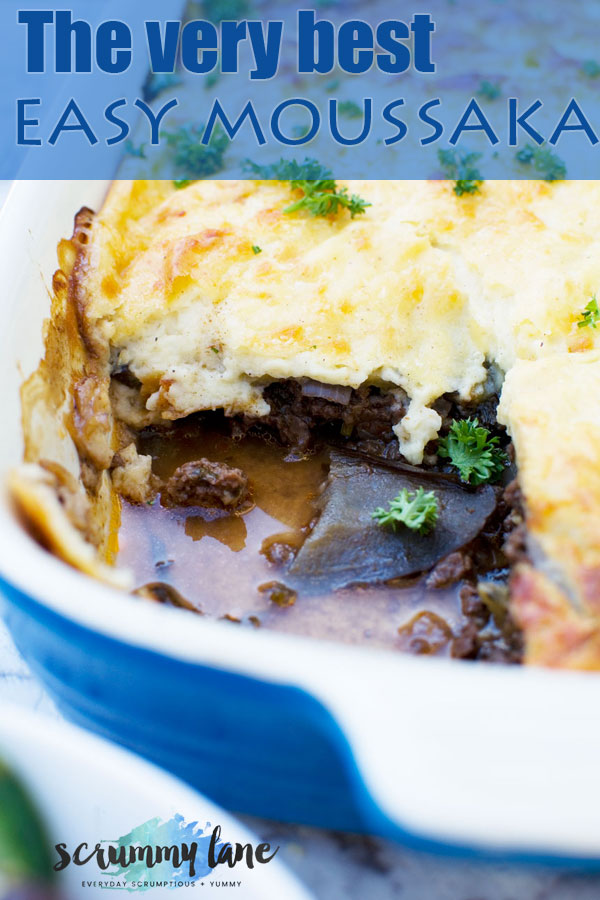
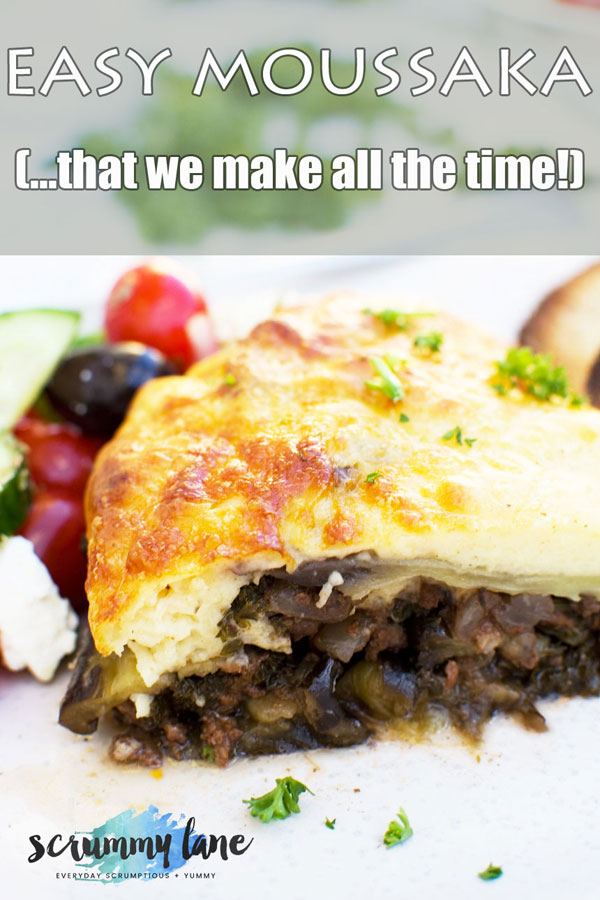
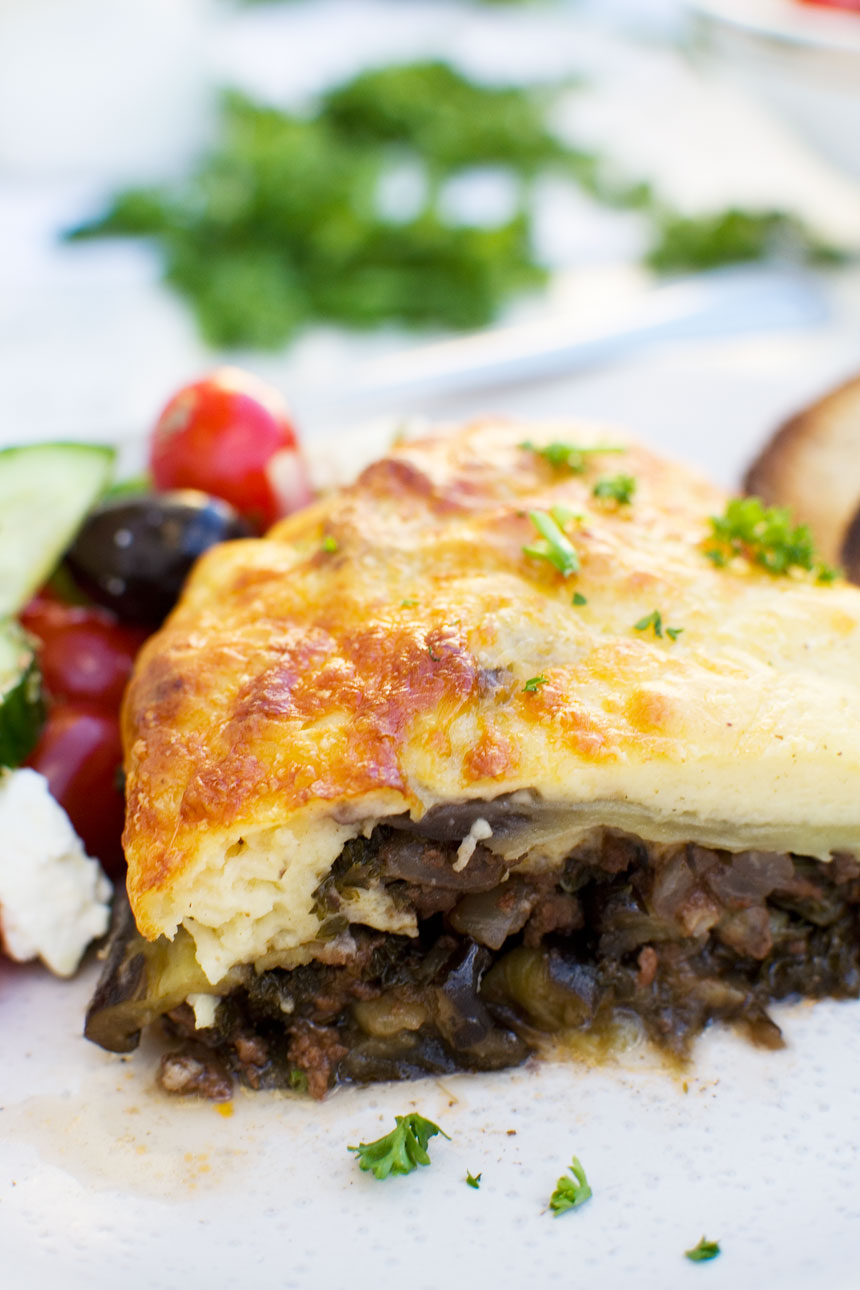
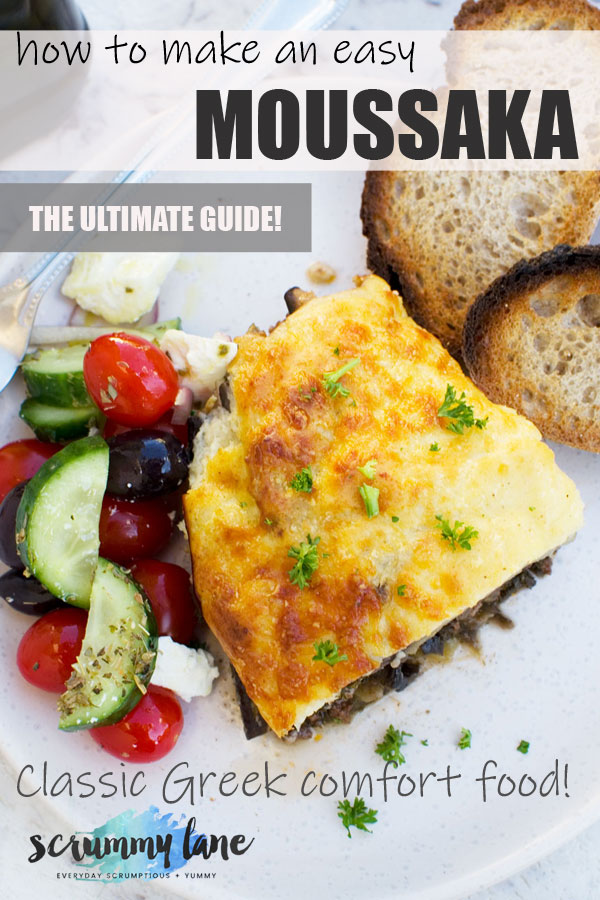
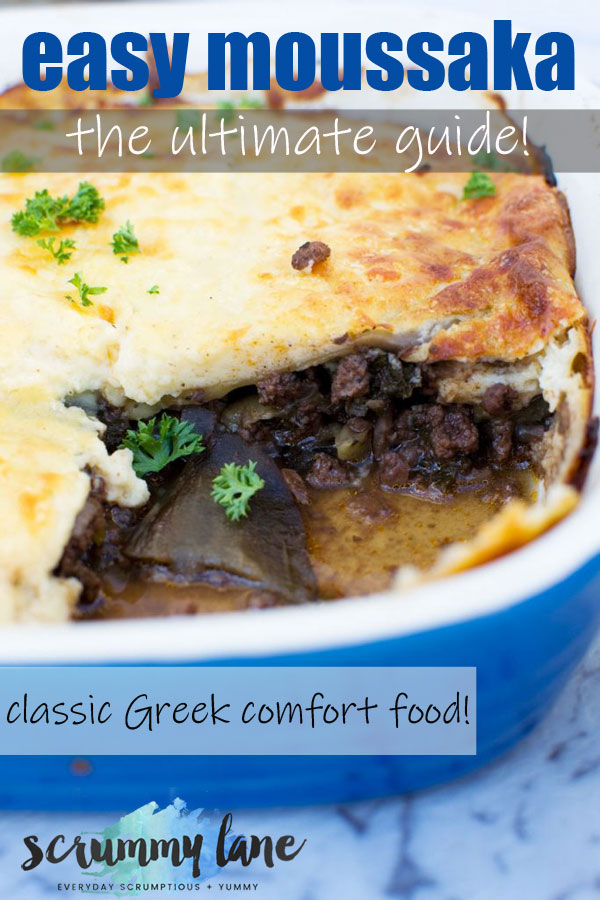
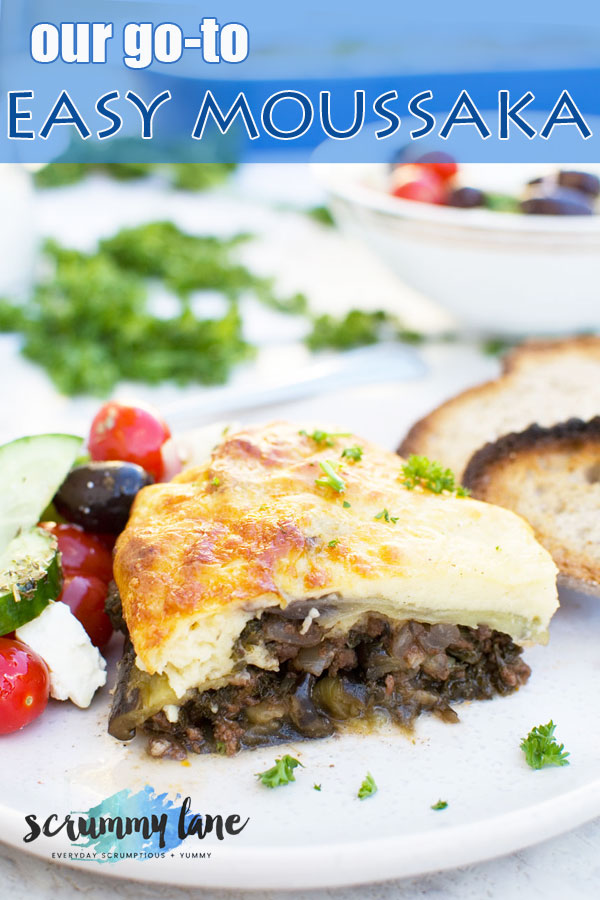
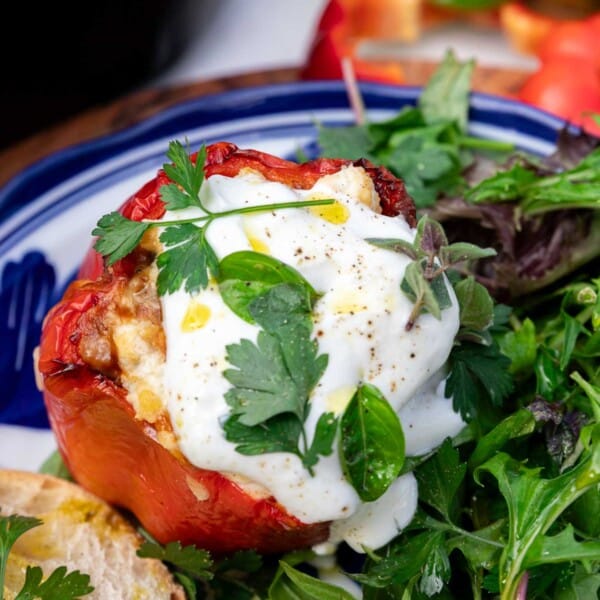
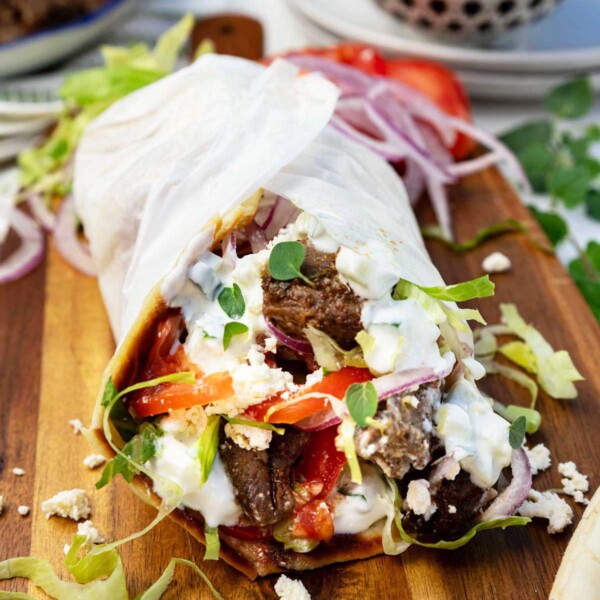
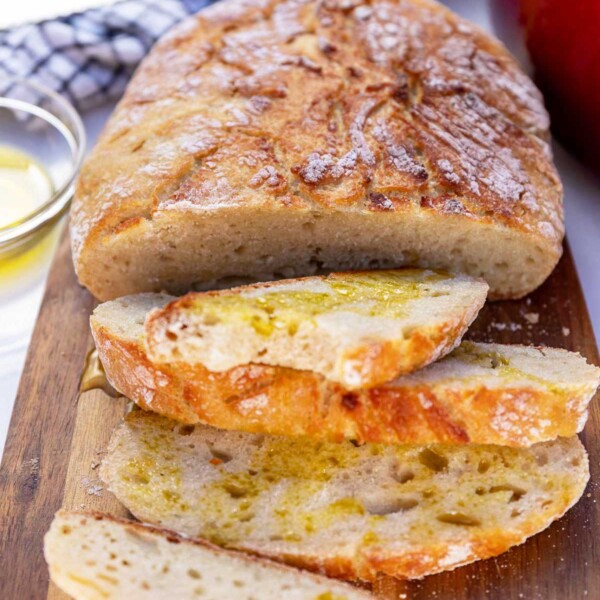







Having visited Greece many times, every year since 1985, Greek food is one of our favourites. Am missing our trip this year due to Covid 19 so decided to start cooking some Greek dishes. Was always scared to try a Moussaka with all the frying of aubergines, but baking them is brilliant!
Absolutely delicious & now a regular feature at home.
Now to try something else…..
Thank you!!!
Hello Mel! Yes, Greece can be a little addictive can’t it, as well as the food! I’m sooo happy you enjoyed this recipe! Yes, I much prefer baking the aubergines. That way you don’t have to babysit them while they cook either. I’m just about to post a recipe for gemista – maybe you’d like to try that one too? You can sign up for regular updates but it should be published within the next couple of days. Thanks so much for the review!
WOW… this was amazing and so easy to make, I used lamb mince, but followed your recipe and instructions .
First time that I’ve made Moussaka and definitely won’t be the last, the family loved it 🥰
It’s fabulous, isn’t it? I’m so glad your first experience of making moussaka was a good one! Just fyi, I’ll be publishing a new Greek recipe within the next few weeks (yemista or stuffed peppers and tomatoes) which is equally as delicious! If you sign up for my emails you’ll get a notification when it’s been posted! Thank you so much for reporting back, Kathy!
My third attempt at making Moussaka
,at last i got it right,Thanks to your lovely recipe Helen. I fell in love with Moussaka whilst working in Rhodes 40 years ago [and Metaxa Brandy] and i think i made a genuine copy this time. thanks again.
kind regards
John
Hi John! So happy to read this today! I feel like this is a recipe I’ll be using my whole life. I’m so glad it lived up to your expectations! Have you also tried my Greek chicken and potatoes? Also amazing (but simple) with a Greek salad on the side.
Please ,what regular do you cook the moussaka at ? Thanks . No I’ve only sent it once..
Hi Susan! At 355F / 180C. I’ve updated the recipe to make it clearer. Hope you enjoy it!
I recently discovered my love for eggplant! I can’t wait to gibs this easy recipe a try. I bet the flavor is out of this world good.
It really is, Jacquelyn, especially as there are relatively few ingredients in each layer! So glad you like the recipe and hope you try it soon!
This was so delicious! I was a little hesitant about the cinnamon, but it adds such an amazing flavor! Thanks for this great recipe!
Oooh yes, once you’ve discovered cinnamon in beef bolognese, you never look back 😉
Hi – Nice recipe. I’m trying it tonight. I’m a bit confused by the amount of red wine though… 2 thirds (2/3) of a cup of 2 or 3 cups?
I wasn’t sure so I used just 1 cup, which actually seems fine.
Hi Peter! Sorry for the slight delay in getting back to you! It is actually two thirds of a cup, but I’m sure 1 cup would be fine too. All the better, in fact! I’ll correct the recipe to make it clearer 😉
Ha, ha , I read it as 2 to 3 cups and thought “thats a lot” so I used 2 which meant it took a while to reduce, but tasted lovely. Next time though I will use the correct amount. The recope is very easy but next time i will start the meat off then do the aubergines as I think that is a good use of the time whilst the ragu is cooking.
Hi Joyce! When did you make the recipe? I’ve just updated it and made the wine measurement a bit clearer, hopefully! I bet you were feeling quite merry after dinner that day! Maybe I need to add a note to the recipe too, though. Thanks so much for pointing this out, as I think another reader made the same mistake. Oops, sorry! But anyway, really glad you enjoyed it, and I hope this makes it into your regular meal rotation! Have a great day! 🙂
Hi Helen, I made it the day before my post. Just before your update. Ive just made it again, this time with lamb mince. On balance, I prefer it with beef. It is a lovely recipe which my husband says tastes just like the moussaka we had in Messini this year. I am going to try some of the other greek dishes too.
Hi Joyce! Thank you so much for letting me know how this went making it with lamb! I’ve never actually tried it, but to be honest I’m not a big fan of lamb so I think I’ll carry on making my moussaka with beef, especially now you’ve told me this!
I consider the fact that your husband thinks this tastes like an authentic moussaka a very big compliment, so thank you!!!
This was a really nice find. I followed all of the suggestions to make it more healthy. Thanks for your recipe!!
Tried making your mousakka tonight. What a mess I made! The sauce overflowed all over the oven! But my gosh was it tasty! My family ate in complete silence and, if you knew them, you would know that that was a rare occasion! Thanks so much for bringing a taste of Greece to a one bed council flat in Hull!
Hello Carrie! Oh dear, I’m so sorry about your oven! I hope you got it nice and clean again!!!
Apart from that though, this message has made my day! Thank you so much for taking the time to leave your feedback. I made this again recently, and it was just as delicious as ever. It sounds like you might have plenty of mouths to eat it all up in one go, but I find it goes quite a long way when you serve it with bread and Greek salad on the side. I’ve even considered making two and freezing one for later because I don’t think it would be too much more effort to cook with double the ingredients.
Anyway, thanks again for such a glowing review! If you liked this, you might also like this Greek chicken and potatoes recipe which I’m just about to update (it’s a really old post but I still make the recipe a lot!). It’s also a one pot meal, but much easier and quicker than the moussaka. I’m making this for my family tomorrow and serving it with a Greek salad.
this is a neat recipe but as a greek who cooks mousaka let me give you the secret of the dish…it’s simply the bechamel,this considers if it’s a succesful,respectable piece of an original greek mousaka.
In order to get a creamy rich bechamel you need double dose of milk(1000 ml),100 gr butter,2 whole eggs plus 3 yolks,6 table spoons of self rising flour and cheese,of course…a mix of kefalotiri,graviera and kefalograviera(about 600 gr in total)
You spread some cheese over eggplants,you mix some cheese in chopped meet,some nutmeg as well,in there, and most of cheese you add in bechamel.You keep some to cover on top….that’s it!
Often we Greeks reduce eggplants and add some fried potatoes,too.
That’s all!
Hope it was helpful to you 🙂
Good evening from Greece!
Anastasia
Kalispera, Anastasia! Thank you so much for reading, and for adding your wonderful tips. I will be trying a moussaka out this way soon! 🙂